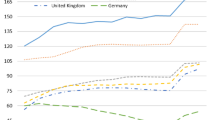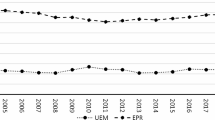Abstract
Since the end of World War II there has been a dramatic decrease in reported Japanese crime. Adult arrest rates have fallen steadily since the early 1950s and juvenile arrest rates have fallen since the early 1960s. An economic analysis of crime predicts that crime rates depend upon returns to crime relative to returns in legal pursuits and the certainty and severity of punishment. Regression analysis is used to test this theory using Japanese data. The empirical results indicate that the economic model does not outperform alternative naive models. However, the results are consistent with the hypothesis that increases in returns to legitimate work diminish both adult and juvenile crime. Unemployment affects some adult crimes but has little impact on juvenile crime. The share of the population in poverty has no significant impact on either type of crime. Increases in the certainty of punishment deters adult crime but there is little evidence that increases in either the certainty or the severity of punishment deter juvenile crime. There is weak evidence to support the hypothesis that increases in the severity of adult punishments deter crime.
Similar content being viewed by others
References
Ames, W. L. (1981).Police and Community in Japan, University of California Press, Berkeley.
Araki, N. (1985). The flow of criminal cases in the Japanese criminal justice system.Crime Delinq. 31: 601–627.
Asia and Far East Institute for the Prevention of Crime and the Treatment of Offenders (1979). Crime trends and prevention strategies in Asian countries.Int. Rev. Crim. Policy 35: 24–37.
Bayley, D. H. (1976).Forces of Order: Police Behavior in Japan and the United States, University of California Press, Berkeley.
Becker, G. S. (1968). Crime and punishment: An economic approach.J. Polit. Econ. 78: 526–536.
Clifford, W. (1976).Crime Control in Japan, Lexington Books, Lexington, Mass.
Cobb, W. E. (1973). Theft and two hypotheses. In Rottenberg, S. (ed.),The Economics of Crime and Punishment, American Enterprise Institute, Washington, D.C., pp. 19–30.
Ehrlich, I. (1973). Participation in illegitimate activities: A theoretical and empirical investigation.J. Polit. Econ. 81: 521–565.
Evans, R., Jr. (1977). Changing labor markets and criminal behavior in Japan.J. Asian Stud. 36: 477–489.
Fair, R. C. (1970). The estimation of simultaneous equation models with lagged endogenous variables and serially correlated errors.Econometrica 38: 507–515.
Fox, J. A. (ed.) (1981).Models in Quantitative Criminology, Academic Press, New York.
Government of Japan, Ministry of Justice (1981).Criminal Justice in Japan, Tokyo.
Government of Japan, Statistics Bureau Prime Minister's Office (1983).Japan Statistical Yearbook, Tokyo.
Gunning, J. P., Jr. (1973). How profitable is burglary? In Rottenberg, S. (ed.),The Economics of Crime and Punishment, American Enterprise Institute, Washington, D.C., pp. 35–38.
Heineke, J. M. (1978). Economic models of criminal behavior: An overview. In Heineke, J. M. (ed.),Economic Models of Criminal Behavior, North-Holland, New York, pp. 1–35.
Henderson, D. F., and Haley, J. O. (1978).Law and Legal Process in Japan: Materials for an Introductory Course on Japanese Law, Compiled for use by students at the University of Washington School of Law, Seattle.
Kelley, A. C., and Williamson, J. G. (1974).Lessons from Japanese Development: An Analytical Economic History, University of Chicago Press, Chicago.
Krohm, G. (1973). The pecuniary incentives of property crime. In Rottenberg, S. (ed.),The Economics of Crime and Punishment, American Enterprise Institute, Washington, D.C., pp. 31–34.
Koshi, G. M. (1970).The Japanese Legal Advisor: Crimes and Punishments, Charles E. Tuttle, Rutland, Vermont, and Tokyo.
Layson, S. (1983). Homicide and deterrence: Another view of the Canadian time-series evidence.Can. J. Econ. 16(1): 52–73.
Mannheim, H. (1941).War and Crime, Watts, London.
McManus, W. (1985). Estimates of the deterrent effect of capital punishment: The importance of the researcher's prior beliefs.J. Polit. Econ. 93(2): 417–425.
Minami, R. (1973).The Turning Point in Economic Development: Japan's Experience, Kinokuniya Bookstore, Tokyo.
Minami, R. (1986).The Economic Development of Japan: A Quantitative Study, Macmillan, London.
Mizoguchi, T., and Takayama, N. (1984).Equity and Poverty Under Rapid Economic Growth: The Japanese Experience, Kinokuniya, Tokyo.
Nagin, D. (1981). Methodological issues in estimating the deterrent effect of sanctions. In Fox, J. A. (ed.),Models in Quantitative Criminology, Academic Press, New York, pp. 121–140.
Nomura, J. (1981).Japan's Judicial System (“About Japan Series” 15), Foreign Press Center, Tokyo.
Parker, C. (1984).The Japanese Police System Today: An American Perspective, Kodansha International, Tokyo.
Schmidt, P., and Witte, A. D. (1984).An Economic Analysis of Crime and Justice, Academic Press, Orlando, Fla.
Shelley, L. I. (1981).Crime and Modernization. Southern Illinois Press, Carbondale.
Skogan, W. G. (1977). Dimensions of the dark figure of unreported crime.Crime Deliq. 23: 41–50.
Taylor, J. B. (1978). Econometric models of criminal behavior: A review. In Heineke, J. M. (ed.),Economic Models of Criminal Behavior, North-Holland, New York, pp. 35–83.
United Nations (various years).UN Demographic Yearbook, United Nations, New York.
Vogel, E. F. (1979).Japan as Number One: Lessons for America. Harvard University Press, Cambridge, Mass.
Wolpin, K. I. (1980). A time series-cross section analysis of international variation in crime and punishment.Rev. Econ. Stat. 62: 417–423.
Author information
Authors and Affiliations
Rights and permissions
About this article
Cite this article
Merriman, D. An economic analysis of the post World War II decline in the Japanese crime rate. J Quant Criminol 7, 19–39 (1991). https://doi.org/10.1007/BF01083130
Issue Date:
DOI: https://doi.org/10.1007/BF01083130




